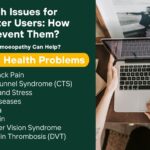Survey of health risks regarding various health issues posed to the people during lockdown concerned more towards their eye health and some symptoms experienced by them such as backache and neck pain due to long hours of work from home. The measures to be taken to avoid the health effects of pandemic are discussed here.


This escalation, the reasons behind it and conscious efforts to reduce the usage of digital media is intriguing and thus a survey among the general population would give insights into many details. This survey worked around the total use of digital media and the symptoms persisting in the responders mainly including the effects on eyes and spine that have a grievous direct effect due to increased screen time. It also reviewed the awareness of the concerned population about the measures to prevent damage.
Effects on eyes and spine due to increased screen time
The survey yield conclusions that are worthy of our attention as certain alarming outcomes have been discovered that are amendable for a healthier life. The majority of the population belonged to the age group of 18-30 years who spent most of their time in front of the screen unaware of the ideal distance that should be maintained to avoid the damage to eyes. Those who worked from home were mandated to spend most of their time working on the computers, careless about the postures they maintained for awfully long hours.
This resulted in the appearance of symptoms like red eyes, watering of eyes, headache, puffiness of eyes, dry eyes, neck pain, backaches and difficulty in inducing sleep. These are classical for computer vision syndrome which can be a forerunner of many eye infections and vision related problems on a long-term basis. Another discovery was that sustained exposure to blue light of the screens could lead to impaired retinal cells further leading to Age related Macular Degeneration (AMD) which causes blurred vision. AMD is a merely manageable condition with nocure !
Increase in backaches and neck pain -“Text Neck Syndrome ”


These conclusions drawn from the survey not only help us in knowing what is next to come but also in strategizing on how to deal with it in the post lockdown period. Certain measures if implemented will greatly affect the outcomes of these potentially life altering health hazards as the factors causing these ill effects can be vastly revamped by small efforts on an individual as well as community basis.
To accelerate the process of preventing the negative impact of lockdown, awareness programs should be planned and executed for everyone to understand the atrocious effects that will impact their whole lives from their usage of digital media. Ophthalmologists and Optometrists should also conduct eye screening programs to not only detect the disease early but also to take the early preventive measures and reduce the damage already caused.
In this era where so much knowledge about everything is available at the fingertips, people still fail to imbibe healthier habits and mitigate the ones that will be life threatening in the long run. Hence such surveys followed by awareness campaigns can be the swords in our long battle to achieve a healthy life.
Prventive measures to protect your eyes and spine during lockdown
1. If you have spectacles while at home wear spectacles as it filters the blue light of the screen more efficiently than lenses.
2. Keep the mobile at a distance of minimum 25 cms from your eyes.
3. Be at a distance of minimum 50 cms from the computer/ laptop screen i.e. at least an arm’s length away.
4. Adjust the brightness of the screen according to the brightness of the surrounding and never read in dim light.
1. 20-20-20 rule:


2. Eye exercises:
These are simple to do. Look left to right two times with your eyes closed and then do the same looking up and down. Then, look at something further away and focus on it while you count to 10 then look at something close while you count to 10. Do this five times. Doing these exercises can help to strengthen your eye muscles.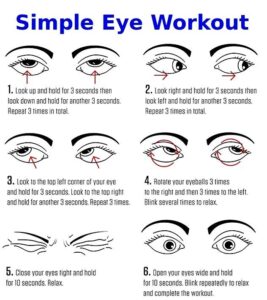

3. Be aware of your posture.
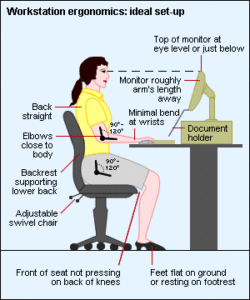

4. Social media updates
Ideal time for social media updates, videos and movies should be maximum 2 hours continuously.
Fact:
The blue light from your screen is an artificial color that mimics daylight. Exposure to blue light can affect your internal body clock and throw off your circadian rhythm. This rhythm is in tune to light and dark. It’s why you feel more tired at night when the sun starts to set and why you feel more energized in the morning when it’s light. Adding in your screen’s artificial blue light right before bed disrupts your body’s internal clock and rhythm as it suppresses melatonin working to maintain this rhythm.


Never eat in front of the screen as it may become a habit over time.
To sum up everything :
If you have any eye related symptoms do any of thefollowing to relieve them:
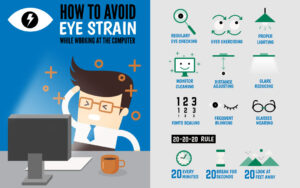



2. An age-old trick that still come handy is cucumber eye patch. If you feel your eyes getting heavy, just cut two slices of cucumber and keep them on your closed eyelids. Keep them on for 5-7 minutes and change sides. It will not only help in relaxing your eyes but will also have a nice cooling effect.


3. If the eyes feel dry blink more. Blinking keeps the surface of our eyes moist with tears. Normally, we blink around 12-14 times a minute, but the blink rate goes down when we are engrossed on screen. This makes our eyes feel itchy and dry. Dry warm weather, air-conditioners and fans can worsen it.
4. Refrain from applying any moisturizer under your eyes, or remember to wipe it off before going to sleep, because that can lead to puffy eyes.
Massage:
1. For eyes which are strained, massaging is an important step.
2. keep your palms on your eyes and gently massage in circular motion.
3. Also massage your eyebrows as well as the area below the eyes.
4. The heat release from the massage will help in relaxing your eyes to the maximum extent.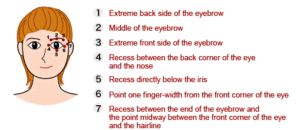

To relieve your neck and back pain do the following exercises:


Text Neck Syndrome:
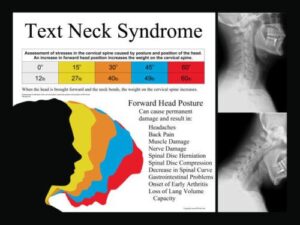

‘TEXT NECK’ refers to overuse syndrome or a repetitive stress injury, where you have your head hung forward and down looking at your mobile electronic device for extended periods of time.
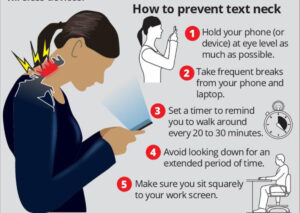

1. Flexing the head forward to use a smartphone directly affects the spine.
2. Tilting the head forward to 15 degrees places about 27 pounds of force on the neck.
3. This increases to 40 pounds at 30 degrees, 49 pounds at 45 degrees and 60 pounds at 60 degrees.
4. Damage caused by untreated text neck can be similar to occupational overuse syndrome or repetitive stress/strain injury.
We hope that this will be helpful to you and following these instructions you will help us build a healthier tomorrow.
Have a happy and healthy quarantine!!!


Heer Yugal Pandit
Final year MBBS student at
Parul Institute of Medical Sciences and Research
(Along with my colleagues Jui Patel, Vidhi Patel and Prashastee Patel)





